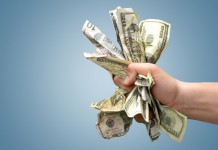 Another day of dollar decline. The currency basically declined for most of the day. It tried to stage a rally several times, but each time when the move failed to recover the earlier high, it just collapsed further. The currency may be suffering from doubts about whether the Republicans can pass a tax reform bill, which seems increasingly unlikely.
Another day of dollar decline. The currency basically declined for most of the day. It tried to stage a rally several times, but each time when the move failed to recover the earlier high, it just collapsed further. The currency may be suffering from doubts about whether the Republicans can pass a tax reform bill, which seems increasingly unlikely.
EUR may have gained – and the dollar suffered – from the developments in Catalonia. Spanish PM Rajoy threatened to arrest Catalan President Puigdemont and suspend Catalonia’s autonomy if they declare independence. The market seems to believe the threat will work: the spread of 10-year Spanish bonds over Bunds came in by 8 bps and is now back to were it was before last week. EUR may continue to gain for some time, but I’m on the edge of my chair waiting to see what happens.
The FOMC minutes described in more detail what we already know from listening to the Committee members and from looking at the dots: that the FOMC members fall broadly into two camps.“Many” participants still believe in the Phillips curve, which relates inflation to the level of unemployment, and expect the tight labor markets to lead to higher inflation. They therefore think another rate hike later this year is warranted. But there is another group of “many” participants who are concerned that the low inflation this year might reflect unknown factors “that could prove more persistant.” And “a few” of those members thought there shouldn’t be another rate hike this year. This is consistent with the four dots on the dot plot that are unchanged from current levels.
The difference here between “many” and “a few” is significant. It implies that some members are skeptical about whether the low level of inflation is really just temporary, but are still willing to go along with rate hikes. The risk for the dollar is that if inflation doesn’t turn up soon, these people may change their minds and decide further rate hikes aren’t warranted until they can better understand the forces that are keeping inflation low. This increases the already high significance for tomorrow’s US CPI data.
As for the Fed’s plans to shrink its balance sheet, the minutes said that “participants generally expected that any reaction in financial markets… would likely be limited” because it’s been well publicized in advance and will be gradual. The minutes didn’t change the market’s estimate of the likelihood of a rate hike in December 2017.
CAD was the best performing currency. Part of it may be generally higher commodity prices (although oil was down slightly), part may be momentum from last week’s impressive wage data, and part may be just USD weakness. Part may also be optimism about the NAFTA negotiations, and that’s where I’m concerned. Canadian PM Trudeau was optimistic after his meeting with Trump to discuss NAFTA and said it was “very possible to get a win” for all sides. However, today’s New York Times, which has a headline: “Trump’s Talk of Scrapping Nafta Could Soon Become Reality.” contradicts this. If the Nafta talks to go badly, at least in the beginning, CAD could weaken as a result. One risk here: a lot depends on how oil reacts to Trump’s Iran speech today.
Today’s market
As usual recently, there’s not much going on during the European day. The EU industrial production figures may be interesting, but they’re not particularly market-affecting.
During the US day, Trump is going to make a speech about US policy towards Iran. Administration officials have said he will decertify the international deal to curb Iran’s nuclear program, just a few days ahead of the 15 Oct. 2017 deadline. He may also announce a more confrontational policy towards Iran, including designating Iran’s Revolutionary Guard a terrorist group. Decertification is not the end of the deal. Technically speaking, the agreement is neither a formal treaty nor an executive agreement but rather a “non-binding political commitment.” Decertifying it only means that the administration is no longer committed to it, but it does not invalidate the agreement. On the other hand, it does signal to Congress that it can reimpose sanctions on Iran when next the sanction wavers expire next January.
It’s unlikely that the move would cause the 2015 accord between Iran and the US, EU, Russia and China to unravel entirely, because the other signatories have said that they stand by the pact. Nonetheless, tighter sanctions on Iran might make it more difficult for the country to produce and export oil. In addition, increased tensions in the Middle East can send oil prices higher.
Higher oil prices tend to be beneficial for RUB, CAD, NOK and MXN.
Brent, the European benchmark, is more sensitive to problems in the Middle East than WTI, the US benchmark is. So when there are problems in the Middle East, Brent usually increases in price relative to WTI.
 The rate of increase in the US producer price index (PPI) is forecast to accelerate significantly at the headline level owing to higher petroleum prices. The year-on-year rate for the core PPI on the other hand is expected to remain unchanged as the strengthening of the dollar last year gradually feeds through. With the employment situation unclear in the wake of the hurricanes, the various inflation gauges have become more important than ever as a way of determining what the Fed is likely to do. A higher PPI is likely to be positive for the dollar.
The rate of increase in the US producer price index (PPI) is forecast to accelerate significantly at the headline level owing to higher petroleum prices. The year-on-year rate for the core PPI on the other hand is expected to remain unchanged as the strengthening of the dollar last year gradually feeds through. With the employment situation unclear in the wake of the hurricanes, the various inflation gauges have become more important than ever as a way of determining what the Fed is likely to do. A higher PPI is likely to be positive for the dollar.
 There are a number of big wigs speaking in Washington at events scheduled around the annual meeting of the IMF and World Bank. ECB President Mario Draghi and Fed Governor Lael Brainard take part in a panel discussion of a paper on monetary policy presented by former Fed Chair Ben Bernanke at the Peterson Institute for International Economics. There are no details available for the paper, but the title of the conference is “Rethinking Macroeconomic Policy.” A host of other economic luminaries will be there and talking during the day, including former US Treasury Secretary Lawrence Summers and Bank of England Chief Economist Andy Haldane.
There are a number of big wigs speaking in Washington at events scheduled around the annual meeting of the IMF and World Bank. ECB President Mario Draghi and Fed Governor Lael Brainard take part in a panel discussion of a paper on monetary policy presented by former Fed Chair Ben Bernanke at the Peterson Institute for International Economics. There are no details available for the paper, but the title of the conference is “Rethinking Macroeconomic Policy.” A host of other economic luminaries will be there and talking during the day, including former US Treasury Secretary Lawrence Summers and Bank of England Chief Economist Andy Haldane.
About the same time, Fed Governor Jerome Powell will speak on “prospect for emerging market economies in a normalizing global economy” elsewhere in Washington. And ECB Chief Economist Peter Praet will speak at a JPMorgan investment seminar there, too (no indication of what he’ll be talking about). Later in the day, Bank of Canada Senior Deputy Gov. Carolyn Wilkins will participate in a panel discussion on “Cashing Out: The End of Paper Currency?” which may be of interest to traders who follow cryptocurrencies.
Oil markets were dealt a blow after the American Petroleum Institute announced that inventories had risen 3.1mn barrels in the latest week. This is a sharp contrast with the forecast for today’s US Dept. of Energy figure is for a drawdown of 2.4mn barrels. If the DoE figures do come out as forecast, I would expect to see oil prices rebound.
 Overnight, China announces its trade figures. The country’s trade surplus is expected to decline, but there are “good” declines and “bad” declines. This is a “good” decline in that it’s expected to be caused by an accelerating pace of import growth rather than decelerating pace of export growth. On the contrary, exports are forecast to have risen at quite a healthy pace. The figures should increase confidence in the Chinese economy and those countries that supply China, meaning it may boost AUD and NZD particularly.
Overnight, China announces its trade figures. The country’s trade surplus is expected to decline, but there are “good” declines and “bad” declines. This is a “good” decline in that it’s expected to be caused by an accelerating pace of import growth rather than decelerating pace of export growth. On the contrary, exports are forecast to have risen at quite a healthy pace. The figures should increase confidence in the Chinese economy and those countries that supply China, meaning it may boost AUD and NZD particularly.




Ichimoku clouds on EURJPY
Let’s look at the four-hour chart. Tenkan-sen line is above Kijun-sen, the blue line is directed upwards, while the red one remains horizontal. Confirmative line Chikou Span is above the price chart, current cloud is ascending. The instrument is trading above Tenkan-sen and Kijun-sen lines; the Bullish trend is still strong. The closest support level is the upper border of the cloud (132.982). One of the previous maximums of Chikou Span line is expected to be a resistance level (133.720).
 On the daily chart Tenkan-sen line is above Kijun-sen, the lines are horizontal . Confirmative line Chikou Span is above the price chart, current cloud is ascending. The instrument is trading above Tenkan-sen and Kijun-sen lines; the Bullish trend is still strong. The closest support level is Tenkan-sen line (132.523). One of the previous maximums of Chikou Span line is expected to be a resistance level (134.305).
On the daily chart Tenkan-sen line is above Kijun-sen, the lines are horizontal . Confirmative line Chikou Span is above the price chart, current cloud is ascending. The instrument is trading above Tenkan-sen and Kijun-sen lines; the Bullish trend is still strong. The closest support level is Tenkan-sen line (132.523). One of the previous maximums of Chikou Span line is expected to be a resistance level (134.305).

 STO is a broker regulated by FCA and CySEC. It offers more than 300 financial instruments such as Forex, Indices, Oil, Stocks, Commodities and Bonds. STO clients have possibility to trade thanks to reliable MT4 and AFX FAST platforms. Check STO offer!
STO is a broker regulated by FCA and CySEC. It offers more than 300 financial instruments such as Forex, Indices, Oil, Stocks, Commodities and Bonds. STO clients have possibility to trade thanks to reliable MT4 and AFX FAST platforms. Check STO offer!
















